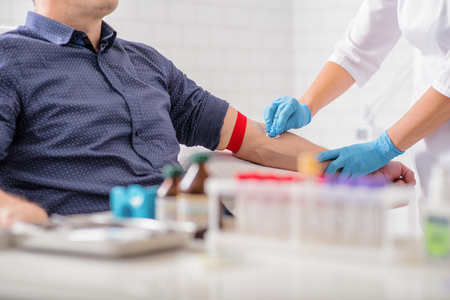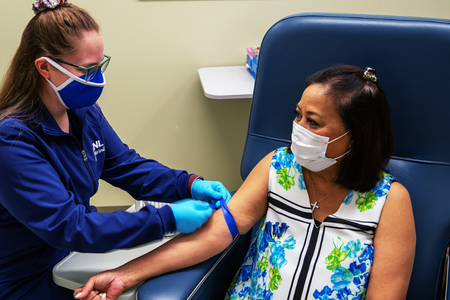Bloodborne Pathogens

What are bloodborne pathogens?
Bloodborne pathogens are diseases that can be spread through blood or blood products. Exposure to blood and other body fluids can be more common than you think, especially in occupations like waste management and maintenance, emergency response, health care, and body artists.
Other factors, like being born between 1945 and 1954 or having high-risk behaviors, may increase the chances of being infected by a bloodborne disease.

What are high-risk behaviors?
High-risk behaviors are actions that increase the chances of contracting a disease or sustaining an injury. Behaviors that may result in exposure to a bloodborne pathogen include intravenous drug use and sex work but not all high-risk behaviors are illegal activities.
Working with needles or infected populations, having unprotected sex, and receiving a blood transfusion are also behaviors that may result in exposure to bloodborne pathogens.
Why does age make a difference?
Adults born between 1945 and 1954 are twice as likely to be infected by a bloodborne pathogen called HCV, or hepatitis C¹. This is because HCV was only identified in 1989. Since 1989, blood donor screenings and harm reduction programs for those using injectable drugs have decreased the number of new HCV infections.
Of the 4.1 million HCV exposures in the United States, 70% of them are in older adults¹. Most of these infections were acquired between 1970 and 1990¹. Because of these factors, older adults are more likely to have HCV than other populations.
What is Hepatitis C?
HCV is a liver infection caused by the hepatitis C virus. Although most infections are in older adults, new HCV infections are on the rise. Today, most infections occur while sharing needles or other equipment used to inject drugs. More than half of people infected with HCV will have a long-term, chronic infection². Chronic HCV can result in serious health problems like cirrhosis and liver cancer.
Unfortunately, most cases of HCV have no symptoms until later stages of the disease. By then, symptoms could include advanced liver disease. Because early treatment of the virus can help prevent chronic infections, it is important to get tested for HCV. If the infection is detected early, treatment can cure most infections in 8 to 12 weeks².
There is no vaccine for HCV. The best way to prevent this infection is to avoid behaviors that can spread the disease, like injecting drugs. Getting tested for HCV is the only way to know your status. Early detection and treatment of this virus can prevent the serious health consequences of chronic, long-term infection.
Other Bloodborne Pathogens
HCV isn’t the only disease that can be transmitted by blood. Some other common bloodborne pathogens include HIV/AIDS, hepatitis B, and syphilis.
HIV/AIDS

Human immunodeficiency virus, or HIV, is a virus that attacks the immune system. Without treatment, the virus progresses to acquired immunodeficiency syndrome, or AIDS, which is a serious disease that may result in death. HIV is spread through contact with blood or infected body fluids. It can also be passed from a mother to her child during birth.
Although there is no cure for HIV, treatment can stop the infection from worsening and can help protect others from being infected. According to the most recent data, almost 1.2 million people are living with HIV in the United States³.
Young people between the ages of 13 and 24 account for 20% of all new HIV diagnoses ³. Even though unprotected sexual contact is the most common method of transmission, injectable drug use causes thousands of new cases each year.
Most people with HIV will have flu-like symptoms within 2-4 weeks which may include:
-
Fever
-
Sore throat
-
Swollen lymph nodes
-
Rash
-
Muscle aches
-
Night sweats
-
Mouth ulcers
-
Chills
-
Fatigue
These symptoms can last as little as a few days or as long as several weeks. However, some people have no symptoms at all. The only way to truly know your HIV status is to get tested. HIV testing can be as simple as a finger-prick. Rapid HIV tests give results in as little as 30 minutes. To learn more about HIV testing, including eligibility, visit the CDC’s website.
For those concerned about potential exposure, please visit a healthcare provider right away! There are HIV medications that, when taken appropriately, reduce the risk of acquiring infection, both before or after exposure.
Hepatitis B

HBV, or hepatitis B, is a liver infection caused by the hepatitis B virus. This infection is spread through blood and other body fluids. Like other bloodborne pathogens, mothers can give the infection to their babies during birth.
Symptoms of HBV can include:
-
Fatigue
-
Poor appetite
-
Stomach pain
-
Nausea
-
Jaundice
Like hepatitis C, not all HBV infections cause symptoms. Untreated HBV infections can become a long-term, chronic illness that might lead to cirrhosis or liver cancer. Infants and young children are more likely to develop long-term infections. Around 90% of infants and up to 50% of young children will remain chronically infected with HBV⁴. Fortunately, there is a vaccine for hepatitis B.
The best way to prevent infection is to get vaccinated. Because HVB infections may not have symptoms, people with high-risk behaviors or occupational exposures of bloodborne pathogens should still be tested for HVB. If you are worried about potential exposure, visit your healthcare provider right away! Infection with HVB can be prevented if you get the vaccine, or a special vaccine called HBIG, within 24 hours of exposure ⁴.
Syphilis
Although syphilis is more commonly spread through sexual contact, it is also a bloodborne pathogen. People with other high-risk behaviors, like injectable drug use, are at risk of contracting syphilis and other sexually transmitted infections.
Syphilis infections can be serious. Without treatment, the infection can damage multiple organ systems, including the heart, blood vessels, brain, and nervous system ⁵.
Often the only symptom of early syphilis is a sore which is round and firm. The sore (or sores) are called chancres. Chancres are usually painless. If syphilis is not treated at this stage, it develops into further symptoms that may include:
-
Fever
-
Sore throat
-
Headaches
-
Patchy hair loss
-
Muscle aches
-
Fatigue
-
A rash on the palms of your hands or soles of your feet
If the infection continues to develop, it can begin to affect your brain, ears, and eyes. The infection can then damage multiple organ systems across your body. These effects may be permanent even with treatment. While most cases of syphilis have been in men, cases in women increased 147% since 2016 ⁶. Mothers can pass syphilis to babies during birth. This is called congenital syphilis.
Cases of congenital syphilis have increased 243% since 2016⁶. In order to avoid the spread of syphilis, it is important to get tested. Unlike other types of sexually transmitted infections, the best way to test for syphilis is a simple blood test HNL Lab Medicine’s Lab Tests Direct is a convenient and affordable option for completing this blood test.
How to prevent bloodborne pathogens

If left untreated, bloodborne pathogens can cause permanent health consequences. Decreasing high-risk behaviors can help you decrease your chances of becoming infected with illnesses such as hepatitis B, hepatitis C, HIV/AIDS, and syphilis. Getting tested for these illnesses is the only way to know your status. Testing allows you to receive treatment as early as possible, and can help prevent the spread of infections to other people.
Speak to your healthcare provider today about testing for bloodborne pathogens, especially if you participate in high-risk activities like sex work, unprotected sex, or injectable drug use. Testing and treatment can save your life and the lives of others. A simple blood test is all it takes!
REFERENCES
¹Reid, M., Price, J. C., & Tien, P. C. (2017). Hepatitis C Virus Infection in the Older Patient. Infectious disease clinics of North America, 31(4), 827–838. https://doi.org/10.1016/j.idc.2017.07.014
²Centers for Disease Control and Prevention. (2020, July 28). Hepatitis C Information. U.S. Department of Health and Human Services. https://www.cdc.gov/hepatitis/hcv/index.htm
³Centers for Disease Control and Prevention. (2022, June 21). HIV Basic Statistics. U.S. Department of Health and Human Services. https://www.cdc.gov/hiv/basics/statistics.html
⁴Centers for Disease Control and Prevention. (2022, March 30). Hepatitis B Questions and Answers for Health Professionals. U.S. Department of Health and Human Services. https://www.cdc.gov/hepatitis/hbv/hbvfaq.htm#treatment
⁵Centers for Disease Control and Prevention. (2022, February 10). Syphilis – CDC Basic Fact Sheet. U.S. Department of Health and Human Services. https://www.cdc.gov/std/syphilis/stdfact-syphilis.htm
⁶Centers for Disease Control and Prevention. (2022, April 12). Sexually Transmitted Disease Surveillance 2020- National Overview. U.S. Department of Health and Human Services. https://www.cdc.gov/std/statistics/2020/overview.htm#Syphilis